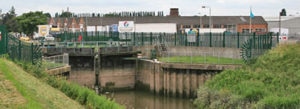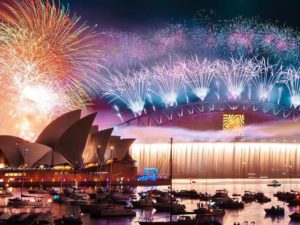Leg 3 Strategic Review Part 3: Final approach
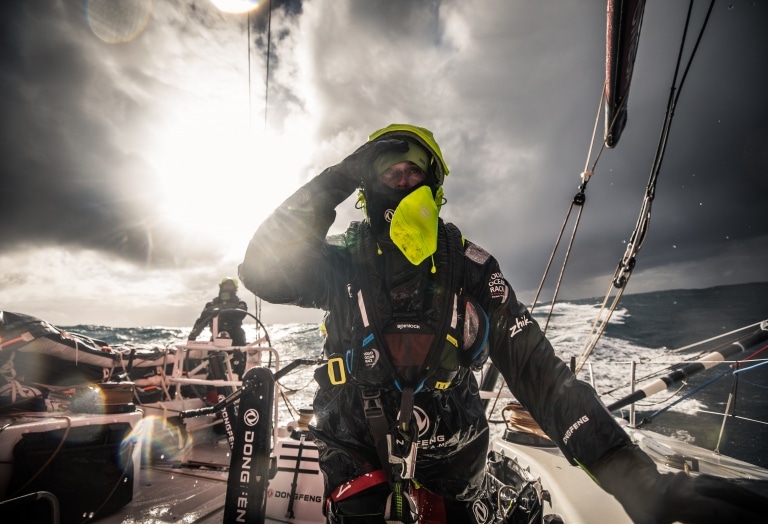 Leg 3, Cape Town to Melbourne, day 12, on board Dongfeng. Fabien Delahaye trimming the front sail before the squall. Photo by Martin Keruzore/Volvo Ocean Race. 21 December, 2017.
Leg 3, Cape Town to Melbourne, day 12, on board Dongfeng. Fabien Delahaye trimming the front sail before the squall. Photo by Martin Keruzore/Volvo Ocean Race. 21 December, 2017.
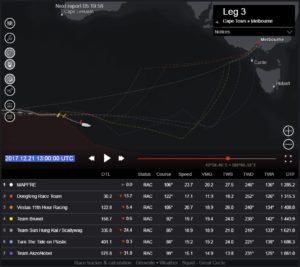
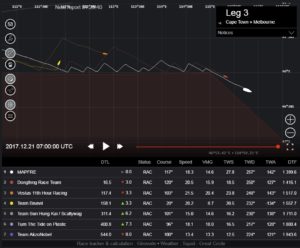
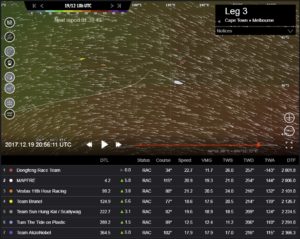
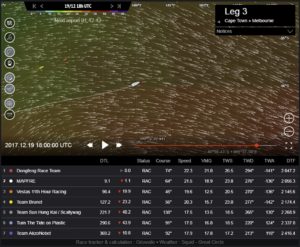
After a week spent hard up against the ropes – weaving like Muhammed Ali in the Rumble in the Jungle – MAPFRE and Dongfeng Racing Team finally broke free of the Ice Exclusion Zone this morning.
All their hard work has been rewarded with open water and a fast final approach to the finish in Melbourne.
Unfortunately, life does not look as smooth for those behind them, as high pressure threatens to add days to the Leg 3 time for the backmarker – the devil takes the hindmost.
There’s not been a lot of strategy in the six days of racing since our last strategic review, but let’s start with a few thoughts on the tactics from those six days because we do, after all, have a new and very deserving leader: MAPFRE.
The set-up
We left the fleet at 13:00UTC on the 15th December and as we see in Image 1, the leaders were already working hard to stay close to the Exclusion Zone (EZ).
The Exclusion Zone has been set by the race officials to keep the fleet clear of Antarctic ice drifting north. It’s a line stretching from west to east and it is marked on the Race Tracker in red – anyone that crosses the line will get a penalty. To be avoided.

The reason the fleet need to stay close to the EZ is that this is where they will find the best and fastest conditions – in the south, in the Westerly Storm Track, where low pressure systems swirl west-to-east around the globe, circulating the Antarctic. North of the Storm Track is an area of much lighter wind in stable, semi-static areas of Subtropical High Pressure. (If you want the background to these areas or Climate Zones as they are called, read our Leg 3 Preview.
Go south
The fastest route for this leg has always been to get south away from the influence of the high pressure and its light winds, and south into the Westerly Storm Track. In the ‘good old days’ boats would get well down into the ‘furious fifties’ – below a latitude of 50S. These days, the Exclusion Zone prevents them going to 50S. The most northerly point of the EZ was 43S on Leg 3.
And so the game has changed to a much more tactical affair, more like something we’d see in coastal or river racing, where the fleet are constantly manoeuvring to stay close to an edge of the race course that gives them an advantage. In this case, the advantage was more wind.
Headed for the corner
The EZ was moved north to 43S not long after the last Strategic Review was published; to keep the fleet safe after there were new reports of ice. We can see from Image 2, from the 17th December at 04:00UTC, that everyone then hightailed it for the new corner of the race course.
I’ve taken the weather off this map, so you can see just how much the EZ was dominating the strategy. Everyone hit that corner, and started gybing down the next stretch of the EZ.
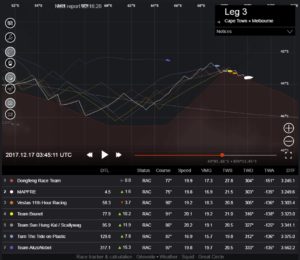
Snapshot
By putting everyone on the same latitude, give or take a mile or two, it gave us an excellent snapshot of the real state of the leaderboard, with Dongfeng (red) holding a 4.5 mile lead from MAPFRE (white).
This pair was a long way in front of Vestas 11th Hour Racing (orange) and Team Brunel (yellow) at 58 and 78 miles behind the leader respectively.
Team Sun Hung Kai / Scallywag was another 20 miles back, Turn the Tide on Plastic 35 miles behind them, and then, still recovering from the damaged mainsail track came Team AkzoNobel, a full 317 miles behind the leader.
If we add the weather to this picture, in Image 3 from 05:30UTC on the same day, 17th December, it tells you all you need to know about the Westerly Storm Track and the Sub-Tropical High Pressure.
The fleet is jammed together on the limits of the EZ, benefiting from a strong north-westerly breeze coming from another big low pressure system to their south.
But just to their north the high pressure and light winds lurk, and it’s not that far away….
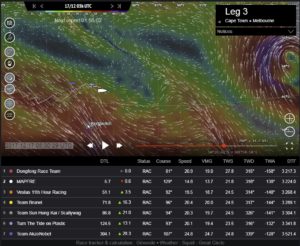
Chasing front
If we skip forward another two days to the 19th December at 06:00UTC in Image 4, again without the weather, we can see how the two leaders have remained glued to the EZ, while behind them, the fleet have started to cut the corner, each trailing boat edging a little further north…
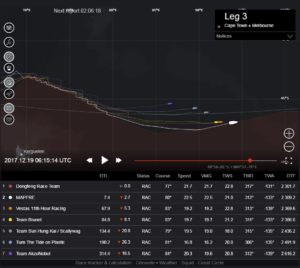
If we add the weather into the picture to get Image 5 from the same time, 19th December at 06:00UTC, we can see why – the low pressure is dragging a cold front with it that is slowly overtaking the fleet. When it gets to them, the front shifts the wind from the north-west (a direction that allows them to sail straight along the EZ) to the west (a direction that forces them to sail at what’s called VMG or Velocity Made Good angles, away from the direct course).
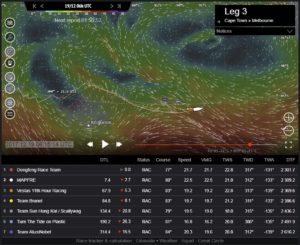
The westerly wind meant putting in lots of gybes and losing significantly to those in the north-westerly wind. Fortunately, the big pain was relatively short-lived, as the wind then continued round to the south-west, once again allowing them to sail straight along the EZ… but it was also a lot lighter behind the cold front – so more pain.
The front inevitably picked off the back of the fleet first and they took their losses.
Stay south
The moment I want to look at is when the leaders reached a tiny inflection point (another corner) in the EZ, at about the same time as the front reached them – captured in Image 6 from 18:00UTC on the 19th December. Dongfeng have worked out a little extension in their lead at this point, now almost ten miles.
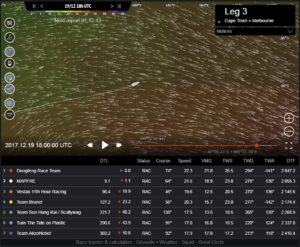
In Image 7 from 21:00UTC on the 19th, just three hours later, we can see that the westerly wind has now reached them both: MAPFRE have gybed first and gone all the way back to the EZ. In contrast, Dongfeng initially went with them, and then gybed away to split and take a more northerly line. It was an expensive decision.
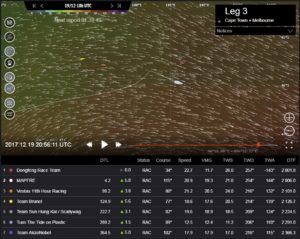
Now positioned further south and in slightly better breeze, MAPFRE slowly overhauled Dongfeng, who eventually gave up their leverage and came onto MAPFRE’s line. So that by Image 9 from 09:00UTC on the 20th, MAPFRE have completely reversed the situation and now hold a six mile lead over Dongfeng. I’ve checked the reports from the boats and Dongfeng don’t appear to have told us why they took that gybe to the north, but the lesson is clear: stay close to the EZ. Stay south.
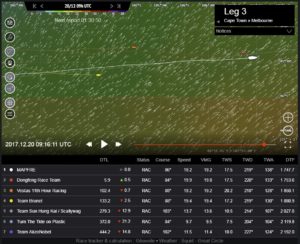
Gybing duel
In the last 24 hours, the low pressure has moved away from the leaders, leaving them in the westerly wind once again. Sailing VMG angles, the gybing duel restarted last night. I’ve taken the weather out of Image 10, from 07:00UTC this morning, 21st December, because I want you to see just how hard MAPFRE have stuck to their strategy. In the 12 hours of sailing shown in that image they’ve gybed 16 times, compared to just eight on Dongfeng.
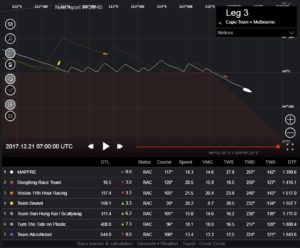
Once again, the stay south strategy has worked; the Spanish boat has increased their lead to 16 miles overnight. They were doing twice the amount of work – and given the amount of time it takes to shift the gear, set up and complete a gybe, the whole crew will have had very little rest.
Work rate
There must be some very tired boys and girls on that boat, but they took the opportunity while they had it – and now they do have the chance to rest as there’s a lot of straight-line sailing coming up. MAPFRE skipper, Xabi Fernandez could have played a blinder here, pushing his crew really hard at the crucial moment to gain what could become an unassailable lead.
Can’t stop the bleeding
Behind the two leaders, it’s a tale of continued losses, and it’s hard to see where the bleeding stops. If we look at Image 11, the latest position report from 12:00UTC today, 21st December, we can see the reason for the latest round of losses. The leaders are clear of the EZ, and able to push south into the big breeze of the low pressure system. While all the way back down the fleet the wind drops as they get closer to the high pressure sitting to their north and west.
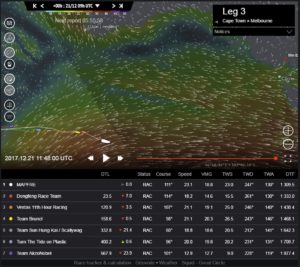
If we compare this moment to Image 2, 17th December at 04:00UTC we can see that the lead over Vestas 11th Hour Racing and Team Brunel has almost doubled, the lead to Team Sun Hung Kai / Scallywag and Turn the Tide on Plastic has tripled. And it won’t be any consolation for those aboard Team AkzoNobel that their losses are less than double, given that they are now 568 miles behind and firmly in the grip of the high pressure.
Setting up for the final approach
I mentioned the semi-static areas of Subtropical High Pressure that sit to the north of the Westerly Storm Track. The finish of the leg is in Melbourne, which sits at latitudes normally dominated by the high pressure in summer. However, as anyone who has lived in that fair city will know – or anyone who has done or followed a Sydney to Hobart Race – those Southern Ocean storms can track a long way north and easily reach the Bass Strait and Melbourne.
In the preview for Leg 3 I considered two options for the finish, and it now seems that we’re going to get both of them. The leaders will benefit from a Southern Ocean storm that will take them all the way to the finish. It should make the final approach fast and relatively straight forward. Everyone else…. not so much.
Two routes
In Image 12 I’ve taken the boats in their latest position at 13:00UTC today, 21st December and run the Predicted Route through to the finish. Again, I’ve taken the weather away so you can see the routes clearly. For some reason, MAPFRE doesn’t have a predicted route, so ignore her, but if we look at the others, we can see that the further down the fleet we look, the further east the Predicted Route takes them.

The predictions are suggesting that Dongfeng Race Team and Vestas 11th Hour Racing gybe around 02:00UTC on the 22nd, and sail for a little less than a day, when they can gybe again and straight-line into the finish.
In contrast, the prediction wants Team Brunel – currently just 40 miles behind Vestas 11th Hour Racing – to make the first gybe a full 24 hours later, around 02:00UTC on the 23rd. The suggested route for Team Brunel is effectively taking the other two sides of a (slightly curvy) paraellogram, before rejoining Dongfeng and Vestas 11th Hour Racing on the final run in to the finish.
Storm moving north
The reason is clear if we add the weather to the picture. First check out Image 13, also from 13:00UTC on the 21st December.
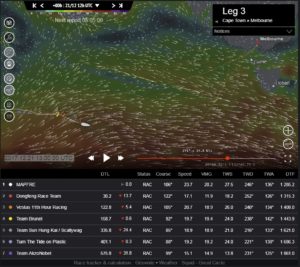
Once again, the low pressure systems running along the Storm Track are visible to the south. And to the north is a mess of high pressure. The high pressure will be slowly pushed north by a low pressure system moving towards Melbourne, visible in Image 14 from 01:00UTC on the 23rd December.
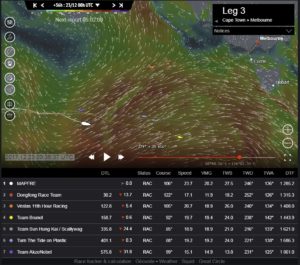
Shutters coming down
If we go forward to Image 15 from 09:00UTC on the 24th December, we can see the high reasserting itself, moving back to the south-east, and starting to block the route into Melbourne with light air. This is the time that MAPFRE and Dongfeng should be finishing, and Vestas 11th Hour Racing and Team Brunel should also just sneak in ahead of the shutters coming down.
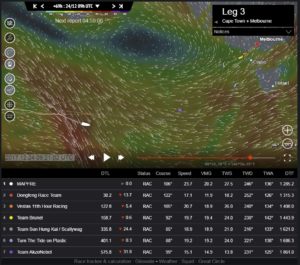
The long way round
Everyone else will have to sail some extra miles to go around the high, and even then they cannot avoid getting caught to some extent. Check out Image 16, from 01:00UTC on the 25th December, and you will see Team Sun Hung Kai / Scallywag and Turn the Tide on Plastic both struggling home through the light air, and Team AkzoNobel going the long way round to eventually finish 3 days after the leaders.
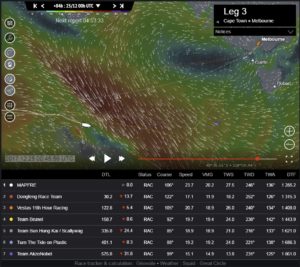
Big split
The most interesting aspect of this is the big split in the predicted routes for Vestas 11th Hour Racing and Team Brunel. The more westerly route favoured for the leaders will be a little bit quicker, as it allows them to take better advantage of the shifts in the wind direction over the next few days, but… And it’s quite a big but… there is a risk of being too far west and getting caught by the high pressure if it moves faster, or is stronger than forecast.
Managing risk
If two boats just 40 miles apart need to take such different routes, it means the timing is critical. So why take the risk just to shave an hour off the time to Melbourne? So I think that we will see most people sticking to the easterly approach to Melbourne to better manage the risk of errors in the forecast.
Big Play
However (there’s always a however, or a but…) if one or both of the leaders do hold on in the south – waiting for another 24-36 hours before they gybe – then it does open a potential passing lane for the boats immediately behind them. They might take a chance on the western route and see if they can make a big play right before the finish.
We could be up for a very exciting endgame to this leg, with a big split and lots of leverage… or it could just be a painful procession, especially for those following the leaders home. We’ll know in the next 24 hours.


